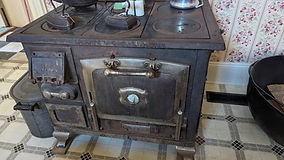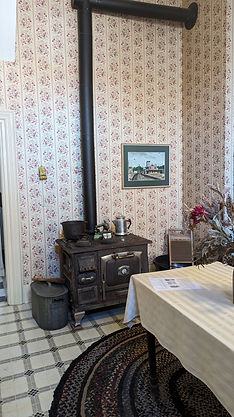The Hamilton County Historical Society relies on the generosity of our community to thrive. We invite you to contribute to our mission of preserving local history and making it accessible to everyone. Clicking on the button will take you to our secure checkout with Square.
The Kitchen
This kitchen was not only the heart of the home, but also of the jail. The sheriff had a small staff, some of them were only part time. The sheriff depended on his family to help with the jail house's duties. The sheriff’s wife was a staff member and received a stipend. She had to prepare meals for the inmates and her family. If there were women or children in the jail; she was also the matron for them.
The sheriff’s children helped when they were needed. Children had chores to do, including cleaning and upkeep of the yard. The children were expected to help in the kitchen. Early days required that there always be firewood in the kitchen so that they could have a good hot stove to cook their meals on. The children were called upon to deliver trays at mealtimes.
The prisoners were served three meals a day. Breakfast was usually simple and consisted of a biscuit, an egg, usually boiled and some coffee. Lunch was also a simple meal, and they had a sandwich, soup, and bread. Lunch varied depending on the seasons, what was available, and sometimes what community members and businesses in the area had and shared with the jail. More than once, a prisoner said that he loved the cooking and the meals that he had here at the jail.
Depending on whether ‘Dad’ was home for the meal, decided on where they ate. If he was away from home, they would eat here in the kitchen. If they were lucky to have Dad home for a meal, then that would sit at the dining room table. Family members of the sheriff who have been interviewed, told us that at holidays, sometimes a long table was set up in the Foyer.
They played wiffle ball outside, had pets, and the courthouse square was their playground. There was a swing in the tree outside the west porch. The sheriff’s children were allowed to have friends sleep over. The attic was a favorite place to play, as well as the downtown square.

The Majestic Manufacturing Company, sometimes called the Majestic Stove Company, produced about two million ranges between the 1880s and the 1940s and was one of the ten largest stove producers in the United States prior to World War II. Many of their ranges are still in use today, and they are very commonly found in stove restoration shops. We have a majestic stove here at the museum.



McDougall was one of the early manufacturers of a Hoosier cabinet. An advertisement from 1919 identified the
McDougall as "the first kitchen cabinet".
George McDougall began the McDougall Company in Indianapolis, Indiana, sometime after the Civil War. The
company's products were pie safes and kitchen tables. Hoosier cabinets were more than just a cabinet; they were a must-have in most homes. The cabinets not only stored
kitchen staples like flour and sugar, they also held workable utensils inside. Most
Hoosier cabinets housed flour sifters, Lazy Susan's for spices, bread boxes, and even meat grinders.
The typical Hoosier cabinet had a large base, sometimes on casters, with a pull-out work surface and several drawers. The top was narrower and had several cabinets and drawers and usually one compartment had
a roll-top or tambour. Most were made of oak or other solid wood. The Hoosier cabinet began to decline in popularity after World War II when more modern appliances began to emerge. Source:https://www.americanantiquities.com/Journal%20Articles/who%20made%20it.html#:~:text=McDougall%20was%20one%20of%20the,pie%20safes%20and%20kitchen%20tables.

The hand pump may seem like an antique to us, but the sheriff and his family were thankful to have “running water” in their home. Before the luxury of the indoor pump, they had to bring their water in from the outside well.
Hand pumps are one of the most ancient water-lifting devices that have been used for thousands of years. In recent centuries, these devices were often installed over community water wells in the days before piped water supplies. During the Industrial Revolution (1760 – 1840), hand pumps became a common sight in Europe and North America. They were used for a variety of applications, including pumping water from wells, cisterns, and water tanks.


A hand pump works by creating a vacuum that draws water up from a well or other water source, such as a borehole. The pump has a piston or plunger that moves up and down inside a cylinder, creating suction that draws water up through a valve at the bottom of the cylinder. As the plunger is lifted, water is drawn into the cylinder through a one-way valve at the bottom, and when the plunger is pushed back down, the water is forced out through a spout or outlet. This process is repeated until enough water has been drawn up or the desired pressure has been achieved.
Antique iceboxes, in principle, work similarly to the modern refrigerator. Simple, yet practical. Given the limitations of the 19th century, the icebox got the job done.
The icebox itself was hollow and lined with zinc or tin.
This lining kept the internal temperature cooler longer. An ice block was placed in the top compartment near food that needed to stay cold. The ice would typically last about two days with the exception of the hot summer months. The design of the icebox and the humidity circulated the cold air in the device. Source: https://blogs.loc.gov/teachers/2019/03/icebox-exploring-states-of-matter-using-historic-photographs/
This is the first CROCK POT
A piece of home cooking history! The Ideal Cooker by The Toledo Cooker Co. was an early version of today’s crock pot or slow cooker. The spacious metal lined well within the wooden housing was designed as a new style of cooking, advertised as economical in fuel saving and in keeping the kitchen cool in warm months. The lid has a supporting hinge and securing latch. Source: https://www.pinterest.com/pin/846324954994313974/
THE TOLEDO COOKER CO. Ideal Cooker


History of our braided rug - with a tuxedo woven in !
Our braid rug history – with a tuxedo woven into it. Braided rugs can be traced back to the 1700’s. They started as all things did back then, of necessity. We wanted to cover our bare wood floors. Wooden floors were not smooth like they are now. Straw mats were first used. Wool was preferred over straw mats as they were more durable and prettier. Hand braided rugs continue to be a favorite with many, even today.
Noblesville native Denzel Hufford loved many things, besides her main love of gardening, Mrs. Hufford also caned chairs and braided wool rugs. She was a longtime member of the Huckeepudler Rug Hooking Association. We are fortunate to have one of her rugs donated to us at the Historic Sheriff’s residence and jail on the square in downtown Noblesville. Most of everything that Denzel was involved in she always threw in a little bit of fun with it. Our kitchen rug is no different. Denzel was married to Marvin ‘Red’ Hufford, who was a very well-known big band leader in the 30’s and 40’s in Indiana and surrounding states. Denzel used some of Red Hufford’s tuxedo’s that he wore as a band leader to make the rug that we have in the kitchen of the sheriff’s residence. All the black fabric is from his tuxedo’s. Recently at the historic sheriff’s residence and jail we took some time to repair the rug in the kitchen. Board members, Nancy Massey, Janet Phillips, and Sandra Lynch. During our ‘sewing bee’ we began to wonder about the history of this rug, and we wanted to share that story.
.jpg)
